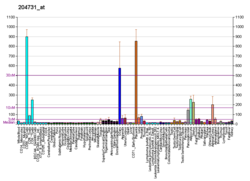TGFBR3
Appearance
Betaglycan also known as Transforming growth factor beta receptor III (TGFBR3), is a cell-surface chondroitin sulfate / heparan sulfate proteoglycan >300 kDa in molecular weight. Betaglycan binds to various members of the TGF-beta superfamily of ligands via its core protein, and bFGF via its heparan sulfate chains. It is not involved directly in TGF-beta signal transduction but by binding to various member of the TGF-beta superfamily at the cell surface it acts as a reservoir of ligand for TGF-beta receptors.[5][6]
See also
References
- ^ a b c GRCh38: Ensembl release 89: ENSG00000069702 – Ensembl, May 2017
- ^ a b c GRCm38: Ensembl release 89: ENSMUSG00000029287 – Ensembl, May 2017
- ^ "Human PubMed Reference:". National Center for Biotechnology Information, U.S. National Library of Medicine.
- ^ "Mouse PubMed Reference:". National Center for Biotechnology Information, U.S. National Library of Medicine.
- ^ Andres JL, Stanley K, et al. (1989). "Membrane-anchored and soluble forms of betaglycan, a polymorphic proteoglycan that binds transforming growth factor-beta". J. Cell Biol. 109 (6 (Pt 1)): 3137–3145. doi:10.1083/jcb.109.6.3137. PMC 2115961. PMID 2592419.
- ^ Andres JL, DeFalcis D, et al. (1992). "Binding of two growth factor families to separate domains of the proteoglycan betaglycan". J. Biol. Chem. 267 (9): 5927–5930. PMID 1556106.
Further reading
External links
- betaglycan at the U.S. National Library of Medicine Medical Subject Headings (MeSH)





